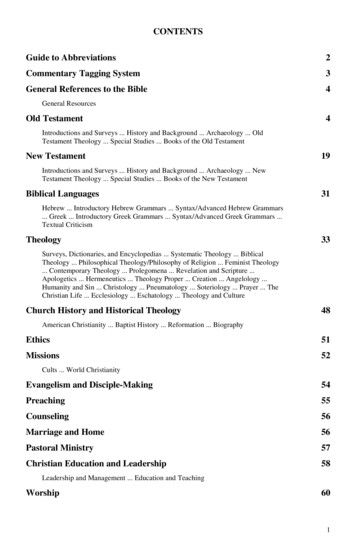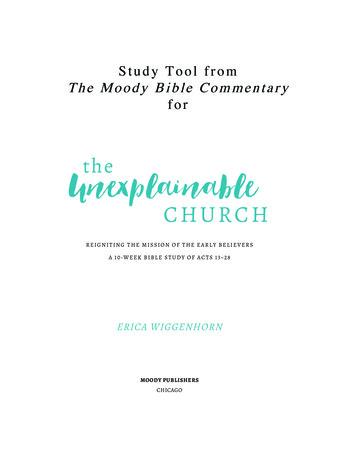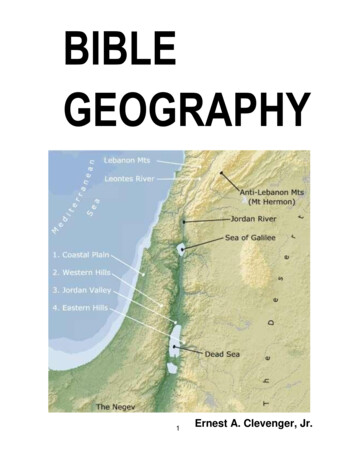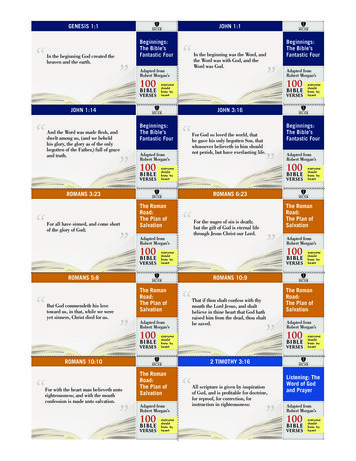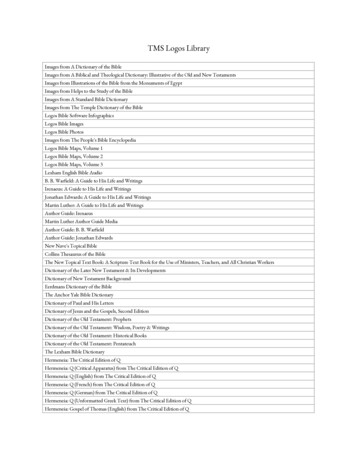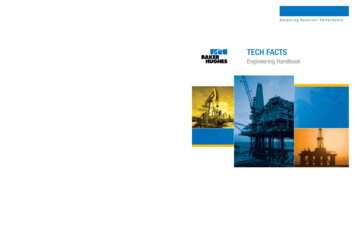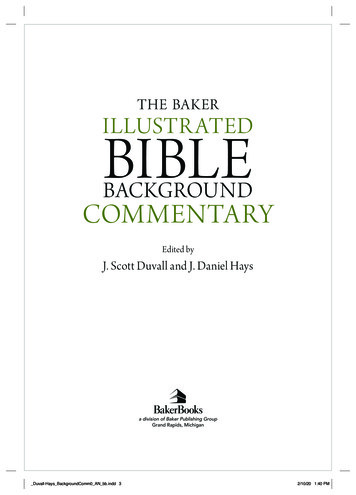
Transcription
THE BAKERILLUSTR ATEDBIBLEBACKGROUNDCOMMENTARYEdited byJ. Scott Duvall and J. Daniel HaysCDuvall-Hays BackgroundComm0 AN bb.indd 32/10/20 1:40 PM
2020 by Baker Publishing GroupPublished by Baker Booksa division of Baker Publishing GroupPO Box 6287, Grand Rapids, MI 49516-6287www.bakerbooks.comPrinted in ChinaAll rights reserved. No part of this publication may be reproduced, stored in a retrieval system,or transmitted in any form or by any means— for example, electronic, photocopy, recording— without the prior written permission of the publisher. The only exception is brief quotations inprinted reviews.Library of Congress Cataloging- in- Publication DataNames: Hays, J. Daniel, 1953– editor. Duvall, J. Scott, editor.Title: The Baker illustrated Bible background commentary / edited by J. Scott Duvall andJ. Daniel Hays.Description: Grand Rapids, Michigan : Baker Books, a division of Baker Publishing Group,[2020] Includes bibliographical references.Identifiers: LCCN 2019035113 ISBN 9780801018374 (cloth)Subjects: LCSH: Bible—Commentaries.Classification: LCC BS491.3 .B345 2020 DDC 220.7—dc23LC record available at https://lccn.loc.gov/2019035113Unless otherwise indicated, Scripture quotations have been taken from the Christian StandardBible , copyright 2017 by Holman Bible Publishers. Used by permission. Christian StandardBible and CSB are federally registered trademarks of Holman Bible Publishers.Scripture quotations labeled NASB are from the New American Standard Bible (NASB), copyright 1960, 1962, 1963, 1968, 1971, 1972, 1973, 1975, 1977, 1995 by The Lockman Foundation.Used by permission. www.Lockman.orgScripture quotations labeled NIV are from the Holy Bible, New International Version . NIV .Copyright 1973, 1978, 1984, 2011 by Biblica, Inc. Used by permission of Zondervan. Allrights reserved worldwide. www.zondervan.com. The “NIV” and “New International Version” aretrademarks registered in the United States Patent and Trademark Office by Biblica, Inc. Scripture quotations labeled NRSV are from the New Revised Standard Version of the Bible,copyright 1989 National Council of the Churches of Christ in the United States of America.Used by permission. All rights reserved.Scripture quotations labeled RSV are from the Revised Standard Version of the Bible, copyright1946, 1952 [2nd edition, 1971] National Council of the Churches of Christ in the United Statesof America. Used by permission. All rights reserved worldwide.20212223Duvall-Hays BackgroundComm0 AN bb.indd 4242526 76543212/10/20 1:40 PM
� xiiIntroduction J. Daniel Hays and J. Scott Duvall xxivThe Old TestamentIntroduction to the Old Testament J. Daniel Hays 3General Background ArticlesThe Assyrians Gary V. Smith 15The Babylonians Douglas J. E. Nykolaishen 21The Canaanites and Canaanite Religion Catherine L. McDowell 27The Cushites J. Daniel Hays 32Daily Life in Ancient Israel H. H. Hardy II 37The Egyptians Safwat Marzouk 42Musical Instruments in Israel and the Ancient Near East J. Daniel Hays 48The Persians Mark J. Boda 52The Philistines Catherine L. McDowell 60Prophets in the Old Testament World Samuel A. Meier 63Warfare in the Old Testament Boyd Seevers 65Women in the Old Testament World Mark W. Chavalas 69Women’s Fashion in the Old Testament World Marcella Barbosa 74CommentaryGenesis Tremper Longman III 81Exodus Eric Alan Mitchell 121Leviticus R. Dennis Cole 149Numbers Roy E. Gane 169viiDuvall-Hays BackgroundComm0 AN bb.indd 72/10/20 1:40 PM
Deuteronomy Michael A. Grisanti 187Joshua Boyd Seevers 207Judges Boyd Seevers 227Ruth J. Andrew Dearman 2511–2 Samuel Robert B. Chisholm Jr. 2591–2 Kings Catherine L. McDowell 2931–2 Chronicles Samuel A. Meier 329Ezra–Nehemiah Gregory Goswell 371Esther Constance E. Clark Gane 391Job John E. Hartley 401Psalms Christine Brown Jones 423Proverbs Richard L. Schultz 459Ecclesiastes Richard L. Schultz 475Song of Songs Gordon H. Johnston 485Isaiah Gary V. Smith 495Jeremiah Gary E. Yates 535Lamentations Gary E. Yates 571Ezekiel Mark F. Rooker 579Daniel William B. Nelson 607Hosea J. Andrew Dearman 623Joel Mark W. Chavalas 633Amos M. Daniel Carroll R. 637Obadiah M. Daniel Carroll R. 650Jonah M. Daniel Carroll R. 653Micah Stephen G. Dempster 659Nahum Gordon H. Johnston 667Habakkuk James K. Bruckner 671Zephaniah Jason S. DeRouchie 676Haggai George Athas 680Zechariah George Athas 685Malachi William B. Nelson 694Intertestamental History Larry R. Helyer 699The New TestamentIntroduction to the New Testament J. Scott Duvall 705General Background ArticlesAncient Letter Writing E. Randolph Richards 716Athletics in the New Testament World Bernie A. Cueto 718Banquets and Meals in the Greco- Roman World E. Randolph Richards 720viiiContents(Unpublished manuscript—copyright protected Baker Publishing Group)Duvall-Hays BackgroundComm0 AN bb.indd 82/10/20 1:40 PM
Baptism in the New Testament World Rodney Reeves 722The City of Ancient Rome Alan S. Bandy 724The City of Corinth Mariam Kamell- Kovalishyn and Josiah McDermott 727The City of Ephesus Mark Wilson 729Crucifixion Joseph R. Dodson 731Demonization and Exorcism in the Greco- Roman World Bernie A. Cueto 733The Family of Jesus Andreas J. Köstenberger 735Honor and Shame in the New Testament World Rodney Reeves 736Hospitality in the New Testament World Dana M. Harris 738Jerusalem in the Time of Jesus Mark L. Strauss 740The Jerusalem Temple Mark L. Strauss 744Jewish Festivals Andreas J. Köstenberger 747Jewish Marriage Customs Alan S. Bandy 749The Jewish Rite of Circumcision Roy E. Ciampa 751The Jewish Synagogue Mark L. Strauss 753Magic in the New Testament World Dana M. Harris 756Messianic Expectations in Jesus’s Day Dana M. Harris 758Money in the New Testament World E. Randolph Richards 761New Testament Household Codes Dana M. Harris 763Pharisees and Sadducees Andreas J. Köstenberger 765Pontius Pilate Andreas J. Köstenberger 767Roman Citizenship Alan S. Bandy 769The Roman Military Alan S. Bandy 771Roman Roads and Travel Mark Wilson 773Roman Rule of Judea Mariam Kamell- Kovalishyn and Josiah McDermott 775The Sabbath Andreas J. Köstenberger 778Samaritans Andreas J. Köstenberger 780The Sanhedrin Rodney Reeves 782Scribes and Teachers of the Law Rodney Reeves 784The Sea of Galilee and Fishing in the First Century Dana M. Harris 786Shipping Practices in the First Century E. Randolph Richards 788Slavery in the New Testament World Dana M. Harris 790Traditional Greek and Roman Gods Mariam Kamell- Kovalishyn and JosiahMcDermott 792CommentaryMatthew Rodney Reeves 795Mark James R. Edwards 857Luke Craig A. Evans 899John Andreas J. Köstenberger 953Acts Mark L. Strauss 1003Contentsix(Unpublished manuscript—copyright protected Baker Publishing Group)Duvall-Hays BackgroundComm0 AN bb.indd 92/10/20 1:40 PM
Romans C. Marvin Pate 10671 Corinthians Mark E. Taylor 10932 Corinthians George H. Guthrie 1127Galatians Roy E. Ciampa 1151Ephesians Osvaldo Padilla 1167Philippians Osvaldo Padilla 1177Colossians Osvaldo Padilla 11851–2 Thessalonians Joseph R. Dodson 11911–2 Timothy, Titus Ray Van Neste 1205Philemon Osvaldo Padilla 1222Hebrews Dana M. Harris 1227James Mariam Kamell- Kovalishyn and Josiah McDermott 12551–2 Peter Kelly D. Liebengood 12651–3 John, Jude David L. Turner 1281Revelation Mark 1348Image Credits 1422xContents(Unpublished manuscript—copyright protected Baker Publishing Group)Duvall-Hays BackgroundComm0 AN bb.indd 102/10/20 1:40 PM
— Micah— Nahum— Habakkuk—Zephaniah— Haggai— Zechariah— MalachiZephaniahJason S. DeRouchieIntroduction. Zephaniah, a contemporary with Jeremiah in his early years(and perhaps Nahum and Habakkuk), prophesied during the days of KingJosiah of Judah (640–609 BC), prior to the destruction of Jerusalem by theBabylonians (586 BC). His preaching probably aided with Josiah’s reformsaround 622 BC (2 Kings 23:4–20; 2 Chron. 34:8–35:19). See the introduction in the commentary on Jeremiah.Superscription (1:1)bearytianZephaniah son of Cushi (1:1). Zephaniah’s father is named “Cushi” (“theCushite”), connecting him to ancient Cush, the powerful and influential blackAfrican empire along the Nile River, south of Egypt, in what is modern- daySudan (see the article “The Cushites”). Perhaps his father was an ethnicCushite, or perhaps he looked like a Cushite (perhaps one of his parentswas a Cushite), or perhaps he was named “Cushi” in honor of the Cushites,who had been allies with Judah against the Assyrians.1Son of Hezekiah (1:1). Zephaniah’s great- great- grandfather probably wasKing Hezekiah, the faithful reformer and thirteenth king of Judah (729–686 BC) (2 Kings 18–20; Isa. 36–38). Listing four generations of ancestorswas unusual, and this connection to King Hezekiah may be the reason for it.676Duvall-Hays BackgroundComm2 AN bb.indd 3072/5/20 3:20 PM
Josiah (1:1). Josiah was Hezekiah’s great- grandson, a good king whoreigned in Judah from 640 to 609 BC and instituted much- needed religiousreform (2 Kings 22:1–23:20; cf. 2 Chron. 34:3–35:19).Setting: A Call to Revere God (1:2–18)I will completely sweep away everything (1:2). This echoes the warningthat God gave to Noah just prior to the flood (Gen. 6:7).I will cut off every vestige of Baal (1:4). Baal was a prominent Canaanitegod, the god of storms, rain, and thus fertility (see the article “The Canaanitesand Canaanite Religion”).The pagan priests along with the priests (1:4). This suggests two corrupt groups of apostate priests: illegitimate priests of non- Levitical descent(1 Kings 12:31–32; 13:33–34) and legitimate but still apostate Leviticalpriests.Who bow in worship on the rooftops to the stars in the sky (1:5). Seecomments on Deut. 17:3; 2 Kings 17:16. Astral deities were common in theancient Near East. Although strictly forbidden by God (Deut. 4:19; 17:3–7),they were worshiped both in the northern kingdom of Israel (2 Kings 17:16)and in the southern kingdom of Judah (2 Kings 21:3–21; Jer. 8:2; 19:13).Pledge loyalty to Milcom (1:5). Milcom (or Molech) is an Ammonitegod, often associated with child sacrifice(Lev. 18:21; 20:2–5). Yet this term couldalso be translated as “their king,” in whichcase it would be a reference to Baal, theCanaanite deity mentioned in 1:4.He has consecrated his guests (1:7).This likely refers to the Babylonians,whom the Lord consecrated to destroyJudah (cf. Isa. 13:3).The officials, the king’s sons (1:8).These were Judah’s public leaders as wellas members of the royal court.All who are dressed in foreign clothing (1:8). This may indicate foreign influence in the royal court. Some suggestthat it refers to priests who worship foreign gods and thus dress in that foreigntradition.2Mesopotamian king with astral deities above.Zephaniah 1:8Duvall-Hays BackgroundComm2 AN bb.indd 3086772/5/20 3:20 PM
All who skip over the threshold (1:9). This probably is a reference to apagan superstition about the entryway into a temple (1 Sam. 5:3–5).Fish Gate . . . Second District (1:10). The Fish Gate was one of the maingates in Jerusalem, located on the vulnerable northern wall (2 Chron. 33:14;Neh. 3:3). The Second District (NIV: “New Quarter”) was an expansion ofJerusalem west of the Temple Mount started during the reign of Hezekiah(2 Kings 22:14; 2 Chron. 34:22).The Hollow (1:11). The “Hollow,” or “market district” (CSB footnote;NIV), probably was located in one of the depressions in the TyropoeonValley, between the Temple Mount and the Second District.Who settle down comfortably (1:12). Literally, the Hebrew phrase is“who thicken on their dregs.” The idiom refers to wine that would thicken andbecome syrupy at the bottom of the container (the dregs). The implicationis that the people were indifferent and unmoved by the prophetic preaching.Their silver and their gold (1:18). Sometimes an invading army couldbe bought off by paying it tribute of silver and gold (cf. 1 Kings 20:3–4).But in this case— the invasion by the Lord— that would prove ineffective.Alternatively, often idols were constructed of silver and gold, and this maybe a metaphorical reference to the ineffectiveness of the idols to deliverJerusalem.Seek the Lord Together to Avoid Punishment (2:1–3:7)Gaza . . . Ashkelon . . . Ashdod . . . Ekron (2:4). These are four of the fivemain Philistine cities, which the Babylonian king Nebuchadnezzar destroyedin 600 BC (see the article “The Philistines”). Gath’s absence from the listsuggests its earlier destruction by the Assyrians (Amos 6:2).Philistines . . . Ammonites . . . Cushites . . . Assyria (2:5–15). See thearticles “The Philistines”; “The Cushites”; “The Assyrians.” Zephaniah buildsa “compass” of punishment around Judah: the Philistines to the west (2:5–7),the Moabites and Ammonites to the east (2:8–11), and the imperial powersof the Cushites and Assyrians to the south and north (2:12–15).Cherethites (2:5). The Cherethites are closely affiliated with the Philistines(Ezek. 25:16), and are perhaps a subgroup whose origin is associated withthe island of Crete (see the article “The Philistines”).Moab . . . Ammonites (2:8). Ammon and Moab were two neighboringcountries to the east of Judah (see comments on Gen. 19:37–38).Like Sodom . . . like Gomorrah (2:9). The destruction of Sodom andGomorrah by God, described in Gen. 19:24–25, is used here as a graphicmetaphor for upcoming terrible judgment on Moab and Ammon. The connection between this story and the Moabites and Ammonites is ironic, for678Zephaniah 1:9Duvall-Hays BackgroundComm2 AN bb.indd 3092/5/20 3:20 PM
Lot, the main character in the story of Sodom and Gomorrah, who survivesthe judgment, was the progenitor of both the Moabites and Ammonites (Gen.19:30–38), those who will now be judged as if in Sodom and Gomorrah.Nineveh (2:13). Nineveh was the capital of Assyria, destroyed by theBabylonians in 612 BC (see the article “The Assyrians”).Roaring lions (3:3). Throughout the ancient Near East rulers often weredepicted as lions in order to emphasize their strength and power (see comments on Nah. 2:11–13). Here, these “lions” are preying on the very peoplethey were to protect.Wait on the Lord to Enjoy Satisfying Salvation (3:8–20)Beyond the rivers of Cush (3:10). This likely refers to the White Nile andthe Blue Nile, the two main tributaries of the Nile River that were associatedwith the empire of Cush (cf. Isa 18:1–2), which lay to the south of Egypt(see the article “The Cushites”).My holy mountain (3:11). This is a reference to Mount Zion in Jerusalem(Ps. 121:1–2; 125:1–2; Isa. 2:2).The Lord your God is among you, a warrior who saves (3:17). Theimage of the Lord as a powerful warrior who fights and defeats Israel’s enemies is common in the OT (e.g., Ps. 24:8; Isa. 42:13; 59:17). Likewise,throughout the ancient Near East numerous deities were described anddepicted as strong, valiant warriors (see comments on Isa. 59:17).Zephaniah 3:17Duvall-Hays BackgroundComm2 AN bb.indd 3106792/5/20 3:20 PM
Title: The Baker illustrated Bible background commentary / edited by J. Scott Duvall and J. Daniel Hays. Description: Grand Rapids, Michigan : Baker Books, a division of Baker Publishing Group, [2020] Includes bibliographical references. Identifiers: LCCN 2019035113 ISBN 9780801018374 (cloth) Subjects: LCSH: Bible—Commentaries.

